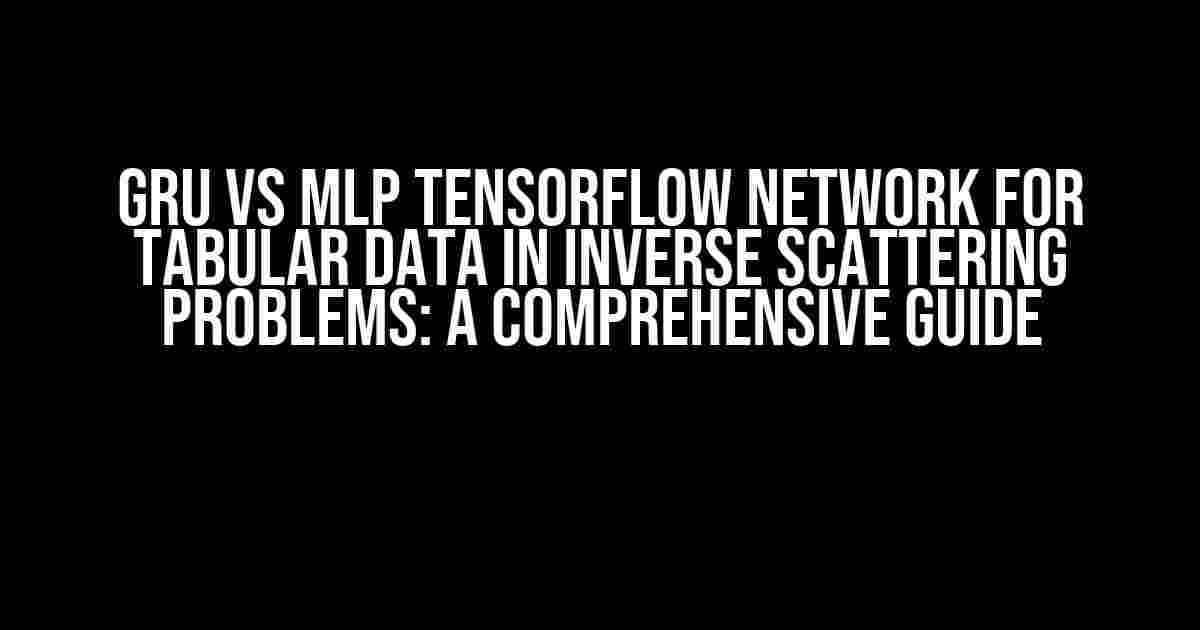In the realm of inverse scattering problems, choosing the right neural network architecture can be a game-changer. With the rise of TensorFlow, developers and researchers have been experimenting with various neural network models to tackle complex problems. In this article, we’ll delve into the world of GRU (Gated Recurrent Unit) and MLP (Multilayer Perceptron) TensorFlow networks for tabular data in inverse scattering problems. We’ll explore the benefits, drawbacks, and implementation details of each model, helping you make an informed decision for your next project.
Understanding Inverse Scattering Problems
Inverse scattering problems involve reconstructing the properties of an object or medium from scattered data. This is a challenging task, as the relationship between the scattered data and the object’s properties is often nonlinear and complex. Inverse scattering problems are ubiquitous in various fields, including:
- Medical imaging: reconstructing tissue properties from MRI or CT scans
- Material science: determining material properties from scattering data
- Seismology: reconstructing subsurface structures from seismic data
Why Tabular Data?
In inverse scattering problems, tabular data is often used to represent the scattered data. This type of data is particularly useful when dealing with:
- Discrete measurements: scattered data is often collected at specific points or frequencies
- Structured data: tabular data can capture the relationships between different variables
GRU (Gated Recurrent Unit) Networks
GRU networks are a type of Recurrent Neural Network (RNN) that excels in sequential data processing. In the context of tabular data, GRU networks can be used to:
- Model temporal relationships: capture patterns and trends in the data
GRU Architecture
import tensorflow as tf gru_layer = tf.keras.layers.GRU(units=128, return_sequences=True)
In this example, we define a GRU layer with 128 units and set `return_sequences=True` to preserve the temporal relationships in the data.
GRU Benefits
- Handles sequential data with ease
- Capable of learning long-term dependencies
- Fast training and inference times
GRU Drawbacks
- Requires careful tuning of hyperparameters
- Can be sensitive to initializations and batch sizes
- May not perform well with small datasets
MLP (Multilayer Perceptron) Networks
MLP networks are a type of feedforward neural network that excels in modeling complex relationships between variables. In the context of tabular data, MLP networks can be used to:
- Model nonlinear relationships: capture complex interactions between variables
MLP Architecture
import tensorflow as tf mlp_layer = tf.keras.layers.Dense(units=128, activation='relu')
In this example, we define a dense layer with 128 units and the ReLU activation function.
MLP Benefits
- Easy to implement and interpret
- Handles high-dimensional data with ease
- Can learn complex relationships between variables
MLP Drawbacks
- Can be prone to overfitting
- Requires careful tuning of hyperparameters
- May not perform well with sequential data
GRU vs MLP for Tabular Data in Inverse Scattering Problems
So, which network architecture reigns supreme in the realm of inverse scattering problems? The answer depends on the specific characteristics of your dataset and problem. Here are some general guidelines:
| Characteristic | GRU | MLP |
|---|---|---|
| Sequential data | ✔ | ✖ |
| High-dimensional data | ✖ | ✔ |
| Complex relationships | ✖ | ✔ |
| Small dataset | ✖ | ✔ |
In general, if your dataset exhibits strong sequential dependencies, GRU networks might be the better choice. On the other hand, if your dataset is high-dimensional and exhibits complex relationships between variables, MLP networks might be more suitable.
Implementation in TensorFlow
Now that we’ve discussed the benefits and drawbacks of each network architecture, let’s dive into implementing GRU and MLP networks in TensorFlow for tabular data in inverse scattering problems.
GRU Implementation
import tensorflow as tf
# Define the GRU model
gru_model = tf.keras.Sequential([
tf.keras.layers.GRU(units=128, return_sequences=True, input_shape=(None, 1)),
tf.keras.layers.Dense(units=64, activation='relu'),
tf.keras.layers.Dense(units=1)
])
# Compile the model
gru_model.compile(optimizer='adam', loss='mean_squared_error')
# Train the model
gru_model.fit(X_train, y_train, epochs=10, batch_size=32, validation_data=(X_val, y_val))
MLP Implementation
import tensorflow as tf
# Define the MLP model
mlp_model = tf.keras.Sequential([
tf.keras.layers.Dense(units=128, activation='relu', input_shape=(1,)),
tf.keras.layers.Dense(units=64, activation='relu'),
tf.keras.layers.Dense(units=1)
])
# Compile the model
mlp_model.compile(optimizer='adam', loss='mean_squared_error')
# Train the model
mlp_model.fit(X_train, y_train, epochs=10, batch_size=32, validation_data=(X_val, y_val))
Conclusion
In this article, we’ve explored the world of GRU and MLP TensorFlow networks for tabular data in inverse scattering problems. By understanding the strengths and weaknesses of each architecture, you can make informed decisions about which model to use for your specific problem. Remember to consider the characteristics of your dataset and the requirements of your project when choosing between GRU and MLP networks.
Happy modeling, and may the laws of physics be ever in your favor!
Frequently Asked Question
When it comes to inverse scattering problems involving tabular data, choosing the right neural network architecture can be a game-changer. Here are some frequently asked questions about using Gated Recurrent Units (GRU) vs Multilayer Perceptron (MLP) in TensorFlow networks for tabular data in inverse scattering problems:
What are the key differences between GRU and MLP networks in the context of inverse scattering problems?
GRU networks are particularly well-suited for sequential data, using gates to selectively retain or forget information, whereas MLP networks are better suited for non-sequential data. In inverse scattering problems, GRU networks may be more effective in capturing temporal dependencies in the data, while MLP networks may be more effective in capturing non-linear relationships between variables.
How do GRU and MLP networks differ in terms of computational complexity and training time?
GRU networks tend to be more computationally intensive and require longer training times due to the recurrent architecture, whereas MLP networks are typically faster to train and less computationally expensive. This is important to consider when working with large datasets or limited computational resources.
Can GRU networks handle non-sequential data in inverse scattering problems?
While GRU networks are designed for sequential data, they can still be used with non-sequential data by padding or concatenating the data in a way that simulates sequentiality. However, this may lead to suboptimal performance, and an MLP network may be a better choice for non-sequential data.
How do GRU and MLP networks compare in terms of interpretability and feature importance?
MLP networks are generally more interpretable than GRU networks, as the weights and biases can be easily visualized and analyzed. GRU networks, on the other hand, are more complex and may require additional techniques, such as saliency maps or feature importance, to understand the contributions of individual features.
When should I choose GRU over MLP, or vice versa, for inverse scattering problems involving tabular data?
Choose GRU when working with sequential data or when capturing temporal dependencies is crucial, and choose MLP when working with non-sequential data or when interpretability and simplicity are key. Ultimately, the choice of network architecture depends on the specific problem, dataset, and performance metrics.


